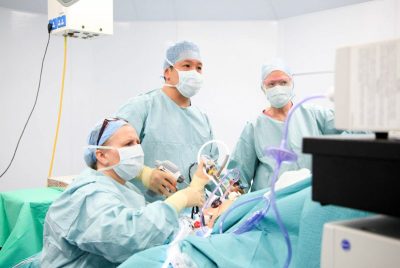
The Complete Guide to Gastric Band Surgery
The adjustable gastric band is a silicone device that is surgically placed around the upper part of the stomach to help you lose weight. This guide explains how it works, who qualifies, and the benefits and risks of the procedure.
Key Takeaways
- Gastric band surgery creates a smaller stomach pouch to restrict food intake, aiding in significant weight loss.
- Eligibility for gastric band surgery requires specific BMI conditions and prior attempts at weight loss through traditional methods, with thorough medical assessments conducted beforehand.
- Long-term benefits of gastric banding include improved health outcomes related to obesity, enhanced self-esteem and quality of life.
- The adjustable gastric band requires ongoing lifestyle adjustments and follow-up care after the procedure.
Understanding Gastric Band Surgery
 Gastric band surgery is a form of bariatric surgery designed to help individuals achieve significant weight loss. An adjustable gastric band is placed around the upper part of the stomach to create a smaller pouch. This smaller pouch limits food intake, causing you to feel full sooner and eat less overall. Gastric banding falls under metabolic and bariatric surgery / weight loss surgery.
Gastric band surgery is a form of bariatric surgery designed to help individuals achieve significant weight loss. An adjustable gastric band is placed around the upper part of the stomach to create a smaller pouch. This smaller pouch limits food intake, causing you to feel full sooner and eat less overall. Gastric banding falls under metabolic and bariatric surgery / weight loss surgery.
The adjustable gastric band, or laparoscopic adjustable gastric banding (lap-band), can be modified after surgery to control the speed at which food passes through the stomach. This flexibility ensures the procedure can be customised to patients individualised needs.
Typically performed laparoscopically, the surgery involves 1 to 5 small abdominal surgical incisions, reducing recovery time, pain and scarring.
How Gastric Bands Work
 Gastric bands promote weight loss by creating a small stomach pouch, significantly limiting food intake and promoting satiety. This pouch helps patients feel full quicker, reducing food intake thus promoting weight loss. The band’s adjustable feature allows a doctor or specialist nurse to either inflate or deflate the band, via an abdominal port, to control food passage through the stomach, offering a tailored approach to food intake management.
Gastric bands promote weight loss by creating a small stomach pouch, significantly limiting food intake and promoting satiety. This pouch helps patients feel full quicker, reducing food intake thus promoting weight loss. The band’s adjustable feature allows a doctor or specialist nurse to either inflate or deflate the band, via an abdominal port, to control food passage through the stomach, offering a tailored approach to food intake management.
Post-surgery, the adjustments to the band (infills or defills) can regulate food movement through the stomach, improving control over feelings of fullness and hunger.
Types of Adjustable Gastric Bands
Various adjustable gastric bands exist, each with unique features to meet individual patient needs. Bands differ in size and adjustability, providing multiple comfort levels and effectiveness. The band can be inflated or deflated via an access port under the skin, usually positioned under the skin at the abdomen.
Eligibility for Gastric Band Surgery
 Patients must meet specific BMI and overall health criteria to qualify for gastric band surgery. Individuals with a BMI of 35 or more or a BMI of 30 or more with obesity-related conditions like Type 2 diabetes or high blood pressure are generally eligible. A BMI of 50 or higher may qualify an individual for surgery without first trying other weight loss interventions.
Patients must meet specific BMI and overall health criteria to qualify for gastric band surgery. Individuals with a BMI of 35 or more or a BMI of 30 or more with obesity-related conditions like Type 2 diabetes or high blood pressure are generally eligible. A BMI of 50 or higher may qualify an individual for surgery without first trying other weight loss interventions.
Patients are usually required to have tried other traditional ways to lose weight, like diet and exercise, before considering weight loss surgery with an adjustable gastric band. Severe and complex obesity, that is a BMI over 35 with an obesity related condition or a BMI over 40, is the primary reason for recommending an adjustable gastric band operation.
Medical Assessments
Medical assessments play a critical role in preparing for weight loss surgery. To assess physical health, patients undergo evaluations by specialists, including blood tests and measurement of vital signs. Regular blood tests post-operatively is encouraged to monitor micronutrient levels to prevent deficiencies after surgery.
Psychological evaluations identify mental health issues that could impact the surgery’s success.
Who Should Avoid Gastric Band Surgery?
Additionally, this procedure should be avoided by those who cannot commit to the long-term dietary and lifestyle changes required following gastric band surgery. To determine what surgery is best for you a consultation with an experienced bariatric surgeon is essential.
Benefits of Gastric Banding
Gastric banding primarily promotes long-term weight loss. It is considered to be less invasive to the stomach and is also reversible. The Lap band enhances overall health and quality of life for people living with obesity / excess weight, by having the potential of improving and reversing obesity related conditions, such as type 2 diabetes.
Long-term Health Improvements
Weight loss from gastric banding notably reduces the likelihood of developing obesity-related diseases and can improve existing ones. Post-procedure, patients often see significant improvements in conditions like Type 2 diabetes.
Psychological Benefits
Successful weight loss post-gastric banding greatly enhances self-esteem and body image, improving quality of life. Many individuals report improved mental health and reduced depression after surgery.
Overall, mental well-being and quality of life significantly improve, making the journey to a healthier lifestyle more attainable.
 Risks and Complications
Risks and Complications
Like any surgery, gastric banding comes with potential risks and complications. Understanding these potential risks is crucial before deciding to undergo the procedure. Short term surgical risks are uncommon. Longterm complications include band erosion, band migration, pouch dilatation, port infection and leakage from the band, tubing or port – which may require revision surgery or band removal.
Careful consultation with a medical professional is crucial to weigh the benefits against the risks. A specialised aftercare programme can help mitigate some of these risks or encourage early detection.
Common Complications
Common Short term complications include:
- Blood clots, deep vein thrombosis or pulmonary embolism
- Wound infections that may develop post-surgery, requiring proper wound care to prevent complications
- Nausea, vomiting, and heartburn due to swelling a the band site or band misplacement
Managing Complications
Managing complications involves regular check-ups and proper care. Band adjustments, following a detailed assessment from a specialised practitioner, can address issues like nausea, vomiting, and swallowing difficulties / food intolerance.
Regular follow-ups ensure the optimal functioning of the gastric band and prompt management of any issues.
Preparing for Gastric Band Surgery
Preparing for gastric band surgery involves significant lifestyle changes, including dietary adjustments and psychological readiness. Patients typically follow a pre-operative diet to prepare their bodies for the operation. This pre-operative diet is also essential to help reduce the size of the liver, making the procedure less complex and safer.
This period also involves enrolling in nutritional counselling, psychological evaluations, physical assessments, and blood tests.
Pre-Surgery Diet / Pre-op Diet / Liver reduction diet
The pre-surgery diet prepares the body for surgery. It often emphasises low carbohydrates and fats to minimise liver size, making the surgery safer. This diet is low in calories and typically lasts two to three weeks. Following the pre-op diet as advised can also help reduce nausea and low energy following the procedure.
Psychological Preparation
Psychological preparation is crucial for successful laparoscopic gastric banding outcomes. Ongoing psychological support can lead to lasting improvements in self-esteem and mental readiness. Counselling reinforces patients’ motivation and commitment to necessary lifestyle changes post-surgery.
The Gastric Band Procedure
The gastric band operation places an adjustable silicone band around the upper part of the stomach to create a small pouch, limiting food intake. Typically performed laparoscopically, the method uses small abdominal incisions and a laparoscope to position the band. The laparoscopic approach is less invasive, resulting in less pain, minimal scarring and quicker recovery. The surgery, performed under general anaesthesia, lasting 30 to 60 minutes.
The laparoscopic gastric banding surgery is considered less invasive than other weight loss surgeries, making it a popular choice for significant weight loss with minimal surgical impact.
During the Surgery
Small incisions are made across the abdomen to place the gastric band, around the upper part of the stomach. Surgeons typically create 1 to 5 small incisions in the abdomen for a camera and surgical instruments.
The band is positioned around the upper stomach to form a small pouch, limiting food intake. A port is positioned beneath the subcutaneous tissue, usually at the abdomen, and is connected via tubing to the band, around the top of the stomach. The band is adjusted by accessing the abdominal port with a specific needle, by a specialised practitioner.
Recovery in Hospital
After surgery, patients are monitored in a recovery room for complications and are encouraged to get out of bed as soon as possible, to help prevent potential complications such as blood clots and chest infections. The majority of patients are discharged the same day following surgery or remain an inpatient for 1 night. This period ensures close monitoring for a smooth recovery and addresses immediate post-surgery issues.
Patients are generally advised to avoid driving for 7 to 10 days post-surgery to allow proper recovery.
Life with the Gastric Band
For a period of 4 weeks following gastric banding surgery the patient transitions from a fluid diet, to a soft diet, progressing onto a normal textured diet from 4 weeks onwards. The first clinical band adjustment is usually performed, if clinically indicated, at 6 to 8 weeks post-op by a specialised practitioner. Prior to the first band adjustment it is important that all surgical wounds have healed and the patient is tolerating a varied, textured diet, free from symptoms of heartburn, reflux and food obstruction and regurgitation.
Band Adjustments / Infills / Defills
A gastric band adjustment, commonly referred to as a “Infill” / “band fill” / “defill” / “aspiration” is performed by a doctor or specialised practitioner, within a clinical setting. The objective is to achieve a suitable level of portion control and satiety, for the patient, without symptoms of heartburn, food obstruction and food intolerance. The band is inflated (adding of saline) or deflated (removal of saline) by accessing the abdominal port, using a specific needle. It does not require a local anaesthetic and is often completed within a few minutes. The band fill procedure is performed after completion of a detailed dietary and symptom assessment. Following the procedure the patient is often asked to drink a glass of water, if this is well tolerated the patient is free to resume to normal daily activities. To allow for any potential swelling at the sight of the band, following the band adjustment, the patient is often asked to adhere to a fluid diet for 24 hours and then a soft diet for 24 hours after that, resuming to a normal, textured diet from day 3 onwards.
Life after gastric band surgery requires significant lifestyle changes, including adherence to a varied, textured, healthy diet, following a mindful eating approach and regular physical activity, to avoid weight regain. A comprehensive aftercare package often provides guidance and support for up to two years after the surgery.
 Dietary Changes
Dietary Changes
After surgery, patients typically start with a liquid diet for two weeks, transitioning to soft foods for 2 weeks and then slowly progressing to crunchy, textured foods from 4 weeks onwards. Eating small portions and thoroughly chewing food aids digestion and prevents problems such as food getting stuck or food regurgitation. Staying hydrated is crucial; patients should consume 1.5 to 2 litres of fluids daily.
A healthy, balanced diet is recommended to prevent nutritional deficiencies and to promote weight loss and well-being.
Importance of Regular Check-Ups
For optimal results regular follow-up appointments are essential to monitor progress and to adjust the gastric band. These check-ups help ensure that patients are losing weight as expected and allow for any issues to be addressed promptly, such as food intolerance, vomiting, heartburn or reflux.
Comprehensive aftercare, often included in the surgical package, is crucial for the success of the gastric band and for management of potential complications.
Cost and Financing Options
The UK’s cost of gastric band surgery typically ranges between £5,000 and £8,000. Various clinics offer financing options, including interest-free payment plans, to make the surgery more accessible. These plans often allow patients to defer a portion of the surgery cost, payable in equal instalments over a specified period.
What’s Included in the Cost?
The cost of gastric band surgery typically includes various services, from the initial consultation to aftercare. Before proceeding with the surgery, patients receive a personalised quotation outlining the costs and terms.
Mr. Alan Li provides a free consultation option, allowing patients to discuss their needs and expectations before making financial commitments.
Summary
Gastric band surgery offers a viable solution for those living with severe and complex obesity, providing both physical and psychological benefits. While the surgery comes with risks and requires significant lifestyle changes, the potential for long-term health improvements and enhanced quality of life makes it a worthy consideration for eligible candidates. From understanding the procedure and eligibility criteria to exploring the benefits, risks, and life after surgery, this guide has provided a comprehensive overview to help you make an informed decision. If you’re considering this life-changing surgery, consulting with a qualified bariatric surgeon like Mr. Alan Li can help you navigate your options and start your journey towards a healthier life.
Frequently Asked Questions
Arrange a free consultation
To arrange a FREE remote or face-to-face consultation, please complete the contact form, email us or call using the numbers below:
Contact Us
Mon – Fri 8am -5pm
Claire Jenkinson
PA
07851 980363
claire@medsecs.co.uk
Samantha Dickson
Nurse Specialist
07950 447490
sam@alanlisurgery.com
Surgery Eligibility
Check if you are eligible for surgery using the BMI Calculator

